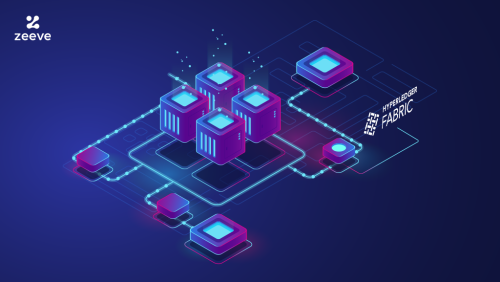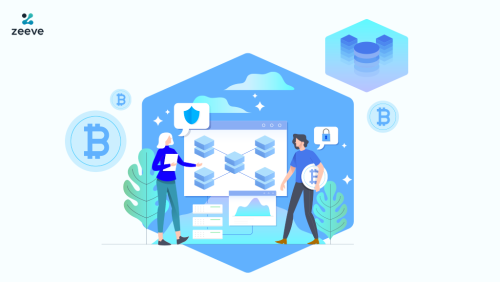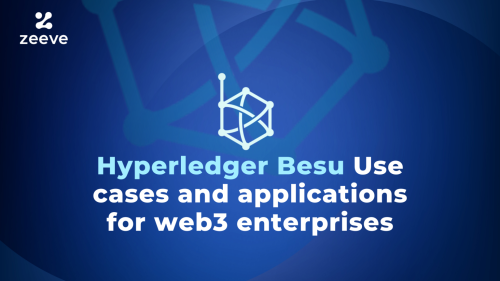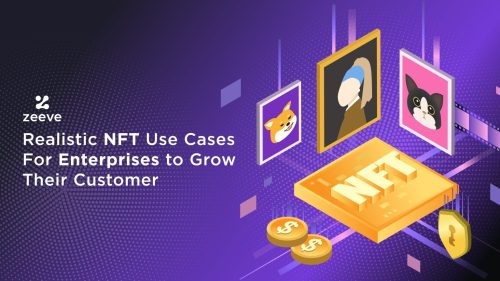
How to build a blockchain network using Hyperledger Fabric
If you are a start-up or enterprise that’s interested in building a blockchain network, Hyperledger Fabric can be a great option. Fabric is a modular platform that allows you to build your own blockchain network, and it’s been used by companies like IBM and Airbus. In this blog post, we’ll walk you through how to set up your own Fabric network. We’ll also show you how to use Fabric for prototyping and development. So if you’re ready to start building your own blockchain network, keep reading!
Blockchain is gaining immense popularity and it is not just cryptos and cryptocurrency that forms the core of blockchain but it goes far beyond that. Major industries, including the finance, logistics and transport, supply chain, insurance, healthcare and others are taking steps to adopt the innovative blockchain solutions to bring in greater efficiency and transparency. The innumerable benefits of the blockchain technology have only made enterprises realize the huge potential the technology can have for their business and hence they are fast adopting it.
Before we walk you through the steps with the help of which you can build your own blockchain application with Hyperledger fabric, it is essential to understand some major components, know the basics of server management and also know more about the framework.
What is Hyperledger Fabric?
Hyperledger Fabric is an open-source blockchain framework for running the private, permissioned, blockchain network and runs on Unix-based operating systems. It was initially contributed by IBM and Digital Asset Holdings, LLC. Fabric serves as a base for building applications or solutions with a modular architecture. This private blockchain network is hosted by the Linux Foundation and members can join this blockchain network only on invitation and it cannot be joined by everyone. This permissioned blockchain network implies that the identity and role of each participant is known to other members of the network. Also, every transaction carried out in the blockchain network is verified, validated, authenticated and also monitored. It is possible to operate the Fabric Networks on-premises or also choose the blockchain as a maintenance platform to sustain the registry infrastructure.
Networks that are created between several parties are capable of exchanging sensitive data with each other. Hyperledger Fabric blockchain-related tasks are unusable if the entire blockchain is not integrated with multiple parties. However, it is challenging to identify, due to its flexibility and strength.
Features of Hyperledger Fabric

The Fabric blockchain framework was created with the purpose of creating trust between one or more actors, organizations, or corporate entities. Well-known traits constituting the crucial element of the Fabric network are as follows:
Privacy:
Each and every system on the network needs to be identified by the Fabric.Given that it is a permissioned blockchain network, prospective participants of a Hyperledger –fabric empowered network are required to sign up and group themselves through a Membership Service Provider (MSP). It is a permissioned network with permissioned membership. The most significant feature that the Hyperledger fabric possesses is the aspect of ensuring privacy for the data stored. It is this relevant feature that makes it such an appealing option for building blockchain applications for many businesses across industries. Moreover, the fabric requires no permission for any component of the blockchain and the requirement for the permission is the decision of the designer of the blockchain network.
Membership services
One of the key features of Hyperledger Fabric is its ability to enable membership services for organizations. This means that companies can join the network as either a full node or light client, depending on their needs and requirements. Membership services are also used to enforce access control to the network and its resources.
Channels:
Hyperledger open-source framework allows users the ability to divide the framework into different “channels”, thereby encouraging network members to establish a separate set of transactions that are not accessible and seen by the larger networks. Channels allow participants in a network to securely transact with each other without having to broadcast every transaction to all members of the network. This is useful in bringing down the amount of data which is required to be made public and to be seen by other participants and improves performance. Hence, it allows users and transaction holders to hide sensitive data from the larger network participants with no requirement for access or need for involvement.
Scalability:
Hyperledger fabric is highly known for the appealing feature of maintaining a scalable network for which the business enterprises often choose to use this network for building blockchain apps. This significant trait of the open-source framework helps businesses to rapidly scale the number of nodes taking part in the network as with any kind of implementation. Meanwhile, the system holds the capability to process larger chunks of data even with fewer dedicated resources, thereby allowing users to have the best of the benefits of the fabric. It is possible to build a blockchain network with only a limited set of nodes and it can be scalable on requirement.
Modularity:
Hyperledger fabric architecture lets users add individual elements and implement them at different times. It is observed that several of the components are discretionary and can be completely done away with or can be added later on without actually impacting the functionality.
Companies can use this function to set what the need is and what they don t need. A few important things for consideration for modular architecture or plug-and-play include how membership services are crucial for different identities, how consensus mechanism is developed, appropriate ledger storage, specialized access APIs, and integrating connecting code.
How Does Hyperledger Fabric Work?
The Hyperledger Fabric project is an open source framework designed to improve and develop cross-industry blockchain applications. Fabric is a modular platform allowing for the development of blockchain applications and solutions with a range of governance models and smart contract templates. The Hyperledger Fabric repository is hosted on GitHub.
One of the advantages of Hyperledger Fabric is its ability to support multiple blockchain networks, or in a single deployment. This allows different parts of an organization, or different organizations, to have their own private blockchains that can interoperate with each other. In addition, Hyperledger Fabric supports both permissioned and permissionless deployments, giving organizations the flexibility to choose the appropriate level of security for their needs.
Hyperledger Fabric has been used in a number of production deployments, including we.trade- an e-commerce platform built by nine European banks. The need for data integrity has never been greater than it is now. With the increasing number of regulations mandating that all participants be kept up-to date on certain fields, fabric’s ability to maintain this information becomes more important than ever before so these rules can effectively chase off any possible participant who may try and compete against them by not following suit with others within an industry or sector about which there was no previous agreement beforehand.
Carrying out effective private transactions or contracts with conventional blockchain networks can be a problem for major organizations. For this reason, Hyperledger Fabric was created as a modular, scalable, and safe foundation for installing industrial blockchain solutions.
An open-source, blockchain-branded engine is Hyperledger Fabric. Its key features are invaluable for a business to use blockchain for core applications. The use of a verifiable ID is a primary necessity for carrying out a private industrial network.
What Makes Hyperledger Fabric Apt For Enterprises?
Open-Source
Open-source blockchain framework Hyperledger Fabric is hosted on a Linux-based platform. In addition, there are active developers involved. It is developed to be readily available to the public. Anyone can access and change the team’s source code. It is open for complete community and developer access. Every part of the conceptual code is open to the public. Anyone may improve upon the program, and thanks a lot are offered for related participation.
Private & Confidential
A copy of the full ledger is received by every node in the public blockchain network. So, confidentiality becomes more prevalent as there’s a lot more of everyone’s business on the blockchain network. In addition, the identities and role of the participating members are unverified or unknown.
Given that it is public, anyone can join blockchain. In case of Hyperledger Fabric, the identity of all members is verified, along with the ledger may only be accessed by verified members. This attribute is most effective in sectors in which confidential data is called for, such as banking and insurance.
Provides option to Control Access
Hyperledger Fabric has a digital-to-physical blockchain network. It has specific access controls for specific users. It has its own order-message authorization process and provides additional administration security.
This is helpful if a portion of the members would like to limit accessibility and control the information. It helps only a limited number of participants involved in the transaction to see the data and information. Thus the feature of controlled access is helpful in situations where two competitors are on the same network.
The framework setup gathers and stores information. Here, one competitor may guard its data from being revealed to another competitor.
Chaincode Functionality
The Chaincode function allows you to implement smart contracts with your system’s business rules in a container technology-based hosting model. It uses Pluggable Components, making it easy to adapt to the complexities inherent throughout the economy. This is useful for certain types of transactions, such as changing ownership of an asset.
Real-World Value and Performance
The Hyperledger Fabric distributed ledger is a private network, so there is no need for individuals on the network to verify the transactions that take place there. This aids in speeding up the transactions and also improves overall performance.
How Can You Create Applications Using Hyperledger Fabric?
Hyperledger fabric is a blockchain framework implementation, designed to provide the foundation for developing applications or solutions with an architecture that’s modular in nature. There are several ways you can create your own application using this powerful network technology – here are just a few ways!
One approach is to use the command-line interface (CLI) to generate modules, chains, and organizations. Another option is to use a graphical user interface (GUI) such as Hyperledger Composer. Composer provides an easy way to create smart contracts and blockchain networks without having to use the CLI.
A third option is to use one of the pre-built applications that are available on the Hyperledger Fabric GitHub repository. These applications include sample code, scripts, and dockerfiles that make it easy to get started with Hyperledger Fabric.
Your imaginative choices for creating applications with the Hyperledger Fabric can take place through application of a template, outsourcing, or by creating it in-house. Here’s a brief overview of these three ways. .
Templates
The Hyperledger template is available for use with the Hyperledger blockchain, smart contracts, and apps. A host of professional programmers created it to make the use of blockchain easier and more widely available, so that enterprises would only need small financial and manpower resources to begin.
It may be possible to compare Hyperledger templates with website templates, or their services, in order to understand them better. WordPress enables users to develop any type of website in no more than 30 minutes without any programming experience, web design, or layout skills.
It is not simple to create applications for Hyperledger based on templates. In 5 to 10 years, the templates folder will contain solutions for everything ranging from simple electronic payment transactions to use as a system for voting.
Outsourcing
Operations conducted with the assistance of third-party contractors are referred to as outsourcing. In case of building blockchain applications, it can refer to the process of creating applications, deployments, and tests. You are most likely to find very qualified and highly experienced computer programmers who will be happy to handle the process with precision, and as a result, you need a good deal of money to hire them and won’t wish to engage in your own development.
There are a lot of companies who are developing Hyperledger blockchain applications, but very few competent people in them. Because blockchain is a new innovation, only limited developers worldwide are highly skilled at it.
What to look for when looking for a developer company:
After you’ve completed a list of projects, search for a team that has experience in the type of work that you need to do. Sometimes software products are created and tested for quality, functionality, and utility. Get in touch with the development companies of interest to you and the companies you have already worked with.
If you’re not sure how to structure the working schedule, communication, data exchange, or payment terms, you should either review the many local developers or hire a developer who already works in the specified field.
Hiring your own group of technical developers will allow you to create your own blockchain applications. This means you can fully control the development of this project; however, you’ll need to find coding resources and a programmer workspace.
To save time as well as money, it is sometimes better to hire experts in building blockchain applications who are readily available for your remote job. Whenever you choose this option, however, it is also important to set up the development process well so that one expert can oversee multiple tasks.
Zeeve for building blockchain applications using Hyperledger Fabric
Enterprises and startups can use Zeeve to build, deploy and manage nodes. Zeeve is a Blockchain as Service (BaaS) platform that helps enterprises and startups build, deploy & manage reliable decentralized apps. It has been designed to be cloud agnostic so it can easily interoperate with other networks running on different technologies such as Etheruem and so on. This way you don’t have restrictions when developing your DApps. Furthermore Zeeves offers powerful APIs for creating all sorts of use cases across industries – from banking & financial services ground up through retail stores!–allowing anyone interested in exploring what they’re capable of offering!
The platform offers a wide range of features that make it easy for businesses to get started with blockchain technology. With Zeeve, enterprises can take advantage of the security, transparency and efficiency offered by blockchain technology without having to worry about managing the infrastructure themselves. If you’re looking for an easy way to get started with blockchain, be sure to check out Zeeve. Sign up now!






Responses